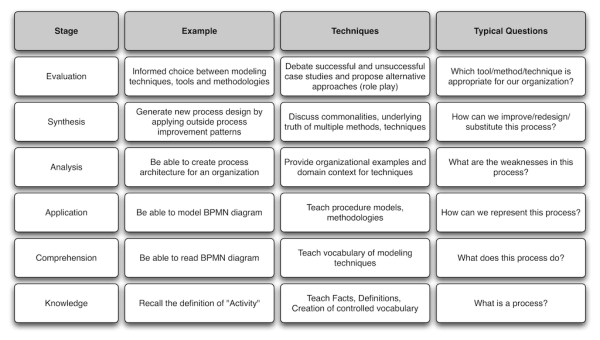Understanding BPM Skills
There are plenty of BPM program offerings to date, ranging from ½-day BPMN modeling workshops to fully accredited academic programs that provide Master’s and MBA degrees with concentrations in Business Process Management. A good way to evaluate the content of these programs is to study the outcome, i.e. what skills you will have acquired once you go through one of these educational offerings. An established standard for learning goals is Bloom’s Taxonomy, first published is 1956. Bloom states that an educational program should specify to what extent the following skills are built (in order of complexity): Knowledge, Comprehension, Application, Analysis, Synthesis, and Evaluation.
Knowledge is concerned with the observation and recall of information. A simple example in the context of BPM would be that a student can define what a process, an activity, a value chain, or a gateway is. Knowledge may extend to dates, events or places. For instance, students may learn the historical origins of BPM technology and the different milestones that led to today’s generation of BPM systems. Another category of knowledge is the recall of major ideas, which would allow students to understand the nominal differences between technologies such as BPM, BI, SOA, and ERP systems. At the highest level of this category is the mastery of the subject matter in terms of definitions and specifications.
Comprehension is concerned with understanding of information, having a grasp of its meaning, being able to translate knowledge into a new context, and being able to predict consequences. Beyond a basic recall of facts (which means simply memorizing definitions), comprehension takes this knowledge to a usable level. Students should be able to put concepts they know into their own words. In the context of BPM, understanding information could mean that a student understands the semantics of BPMN symbols and is able to read the structure of a BPMN process diagram. At the next level, he or she will grasp the meaning of the diagram, i.e. understand its context. One step further is the translation of knowledge into new context, for example the use of process design patterns on a new process. The comparison, interpretation and contrasting of facts allows students to use process metrics to make analytical decisions, and to order a set of processes according to their degree of structure (i.e. from ad-hoc to production processes). At the highest level of comprehension, a student will be able to predict consequences – for instance, he or she may be able to infer the performance of a process from its design.
Application moves the skills acquired as knowledge and comprehension to situations outside the classroom. Students at this level are able to use information, methods, concepts, and theories in new situations. For example, a student that is able to use BPMN to model a previously undocumented process has reached the level of application. Solving problems using the requisite skills or knowledge signals the mastery of the application level.
At the level of Analysis students should be able to compare two related concepts and point out their similarities and differences. This includes the identification of patterns in data, for example the documentation of process patterns or best practices, and the development of reference models. Students should be able to organize parts of a system. In the context of BPM this means that they can create process frameworks or architectures that place individual company processes in a larger context. Up one level from this is the recognition of hidden meanings. This skill implies that students can recognize hidden meanings, an important skill for business analysts. An example would be the evaluation of interview transcripts to identify causes of change resistance in an organization. Finally, students should be able to independently identify components of a system, for instance by using a structured approach to process identification and documentation.
Synthesis skills enable students to develop their own models of the world. They can use old ideas to create new ones. For example, they can apply reengineering patterns to an existing process design to come up with new designs. They should be able to generalize from given facts, extracting patterns and reference models from a collection of industry processes. They should know how to relate knowledge from several areas, e.g. by combining business rule modeling and business process modeling. Finally, students should use all the previously mentioned skills to predict and draw conclusions. For example, a student at this level can use a simulation to forecast the impact of process changes on organizational performance.
The highest level of Bloom’s Taxonomy is Evaluation. Given a particular situation, students should be able to choose an approach or model and explain their choice. They should be able to compare and discriminate between ideas, such as modeling techniques, BPM standards, or tools. They know how to assess the value of theories and external presentations, separating hype from reality. For example, students should be able to critically evaluate a newly proposed BPM standard. Students should be able to make choices based on reasoned argument, for example, select a documentation standard or integration technology based on the context of their project or organization. They need to be able to verify the value of evidence, e.g. they can assess whether the current documentation of a process sufficiently represents organizational reality. Finally, students should be able to recognize subjectivity and act accordingly.
Leave a Comment
You must be logged in to post a comment.








